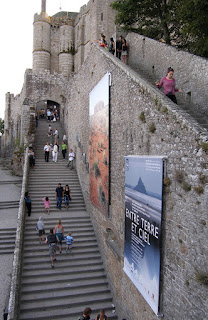August 15: Normandy
 Warm sunshine and clear blue skies welcomed us this morning to a memorable day of exploring Normandy and the Abbey of Mont Saint Michel. Just outside Bayeux lies the Batterie de Longues. Here you can see four German gun batteries which were part of what the Germans called the Atlantic Wall. Walking along the gravel path high above the sea where sailboats today bobbed up and down in the waves, the first one we came to was rusted and derelict. Ivy grows in the crevices in and around the concrete bunker. Three of the bunkers still have guns while a concrete bunker lookout on a ridge above the sea is loaded with pockmarks. Looking around, it's hard to imagine what it must have been like here in 1944. Today the area has gently rolling wheat fields, tidy stone houses with powder blue shutters, and thistles growing alongside poppies.
Warm sunshine and clear blue skies welcomed us this morning to a memorable day of exploring Normandy and the Abbey of Mont Saint Michel. Just outside Bayeux lies the Batterie de Longues. Here you can see four German gun batteries which were part of what the Germans called the Atlantic Wall. Walking along the gravel path high above the sea where sailboats today bobbed up and down in the waves, the first one we came to was rusted and derelict. Ivy grows in the crevices in and around the concrete bunker. Three of the bunkers still have guns while a concrete bunker lookout on a ridge above the sea is loaded with pockmarks. Looking around, it's hard to imagine what it must have been like here in 1944. Today the area has gently rolling wheat fields, tidy stone houses with powder blue shutters, and thistles growing alongside poppies.About 20 minutes down the road overlooking Omaha Beach is the Normandy American Cemetery and Memorial. The 172.5 acre cemetery is a solemn place. Here 9,387 service men and women are buried. Of these, 307 are unknown. A special commemorative garden honors them. Inside the museum are computer screens to look up family members. A large format video tells the personal stories of some of the men and why their families chose to bury them here. Another area has an interactive screen where survivors tell their story.
As you exit through a tunnel to the cemetery, the names of those buried here is read aloud. The cemetery grounds are immaculately maintained. Thousands of white marble crosses, some with the Star of David, are all lined up in perfect precision rows at any angle. Wandering between the crosses it was astonishing how many there were. Visitors of all nationalities were represented. All around us were families with children. "Lead a child down memory lane," said a poster at the museum yesterday. One particularly poignant scene I saw today was a child sitting beside his elders who were in wheelchairs listening intently as they pointed to the beaches and the sea.
Driving on down the coast road we stopped for lunch at Hotel Du Casino at their cafe overlooking the beach. We had mussels Normandy, fresh from the sea as we sat facing the beach and reflecting on what had happened here.
Continuing on the coast road we visited Pointe Du Hoc. On the morning of June 6, 1944, 255 members of the 2nd Ranger Battalion were on a mission to scale the cliffs and destroy the Germany guns. Sadly only 1/3 survived. Today at this location you can see huge craters from the Naval bombardments. Concrete bunkers and rusted barbwire are still strewn about as a reminder of this place.
The sun was still high in the sky as we headed 90 minutes westward along the coastal road to Mont Saint Michel. When you arrive you feel as if you have been there before because it's such a recognizable place. Our visit was just before 7:00 pm which was great because the day trippers were gone. We followed the winding cobblestone lanes to the top where we heard four classical music concerts in four different rooms of the abbey. The first concert was in the main church and featured a harpist who played gracefully. The acoustics were amazing. Those lucky enough to buy their tickets to the abbey after 7:00 as we did were the only ones entitled to the concerts.
Looking out the windows from high above, the tide was coming in, but the water is full of silt. There are plans to eliminate the causeway and once again return Mont. St. Michel to an island. As we headed back down the winding path, we noticed a crowd standing in front of a cafe window. Peeking inside we saw chefs vigorously beating eggs. It turns out these chefs know the secret to making a good omelet and people actually pay 30 Euro ($45) for one.
As the sun set on the horizon and the full moon rose in the sky, we ended the day with a moonlit drive through the countryside back to our hotel in Bayeux.
Comments